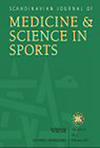艺术体操特异性损伤预防项目的疗效:评估者-盲法集群-随机对照试验
IF 3.5
2区 医学
Q1 SPORT SCIENCES
引用次数: 0
摘要
过度使用损伤在竞技艺术体操运动员中很常见,估计每周患病率为37%,膝盖、下背部和髋关节/腹股沟是最常见的损伤部位。身体能力(如力量和柔韧性)的降低被认为是导致过度使用损伤高发的原因。本试验的主要目的是评估与常规训练相比,以降低膝盖、下背部和髋关节/腹股沟体能为目标的锻炼是否能减少过度使用损伤的发生率。将23个艺术体操俱乐部随机分为干预组(IG: 12个俱乐部和119名体操运动员)和对照组(CG: 11个俱乐部和86名体操运动员)。纳入的体操运动员必须≥12岁,每周训练≥3天。在为期8个月(2022年11月至2023年6月)的训练/热身期间,IG进行了有针对性的伤害预防计划(IPP)。CG进行了常规训练。使用奥斯陆运动创伤研究中心健康问题问卷(OSTRC‐H2),每个月对两组目标地点的过度使用损伤发生率进行测量。OSTRC‐H2的有效率为94%。两组目标部位的过度使用损伤发生率无差异;优势比= 0.86 (95% CI 0.32 ~ 2.29);干预组与对照组的P = 0.77。结果表明,仅仅有针对性的IPP不足以防止竞技艺术体操运动员膝盖、下背部和臀部/腹股沟的过度使用损伤。其他措施(例如负荷管理和适当的培训规划)可能会成为未来研究的目标。试验注册:ClinicalTrials.gov: NCT05506579本文章由计算机程序翻译,如有差异,请以英文原文为准。
Efficacy of a Rhythmic Gymnastics‐Specific Injury Prevention Program: An Assessor‐Blinded Cluster‐Randomized Controlled Trial
Overuse injuries are common among competitive rhythmic gymnasts, with an estimated weekly prevalence of 37% and with the knees, lower back, and hip/groin as the most common injury locations. Reduced physical capacity (e.g., strength and flexibility) has been hypothesized to contribute to the high prevalence of overuse injuries. The primary objective of this trial was to assess if exercises targeting reduced physical capacity in the knees, lower back, and hip/groin reduce the prevalence of overuse injuries compared with usual training. Twenty‐three rhythmic gymnastics clubs were cluster‐randomized to an intervention group (IG: 12 clubs and 119 gymnasts) and a control group (CG: 11 clubs and 86 gymnasts). Included gymnasts had to be ≥ 12 years of age and training ≥ 3 days per week. The IG performed a targeted injury prevention program (IPP) during training/warm‐up for 8 months (November 2022 to June 2023). The CG performed usual training. The prevalence of overuse injuries in the targeted locations was measured monthly in both groups using the Oslo Sports Trauma Research Centre Questionnaire on Health Problems (OSTRC‐H2). The response rate to OSTRC‐H2 was 94%. There was no difference in the prevalence of overuse injuries in the targeted locations between the two groups; odds ratio = 0.86 (95% CI 0.32 to 2.29); p = 0.77 for intervention vs. control. The results suggest that a targeted IPP alone is not enough to prevent overuse injuries in the knees, lower back, and hip/groin among competitive rhythmic gymnasts. Other measures (e.g., load management and proper training planning) might be targeted in future studies.Trial Registration: ClinicalTrials.gov : NCT05506579
求助全文
通过发布文献求助,成功后即可免费获取论文全文。
去求助
来源期刊
CiteScore
7.90
自引率
4.90%
发文量
162
审稿时长
3 months
期刊介绍:
The Scandinavian Journal of Medicine & Science in Sports is a multidisciplinary journal published 12 times per year under the auspices of the Scandinavian Foundation of Medicine and Science in Sports.
It aims to publish high quality and impactful articles in the fields of orthopaedics, rehabilitation and sports medicine, exercise physiology and biochemistry, biomechanics and motor control, health and disease relating to sport, exercise and physical activity, as well as on the social and behavioural aspects of sport and exercise.

 求助内容:
求助内容: 应助结果提醒方式:
应助结果提醒方式:


